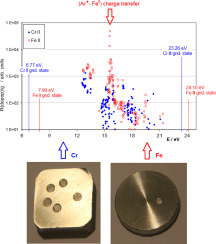当前位置:
X-MOL 学术
›
Spectrochim. Acta B. At. Spectrosc.
›
论文详情
Our official English website, www.x-mol.net, welcomes your
feedback! (Note: you will need to create a separate account there.)
Glow discharge excitation and ionization of chromium, comparison with iron
Spectrochimica Acta Part B: Atomic Spectroscopy ( IF 3.2 ) Pub Date : 2020-04-01 , DOI: 10.1016/j.sab.2020.105792 Zdeněk Weiss
Spectrochimica Acta Part B: Atomic Spectroscopy ( IF 3.2 ) Pub Date : 2020-04-01 , DOI: 10.1016/j.sab.2020.105792 Zdeněk Weiss

|
Abstract Cr I and Cr II emission spectra from a Grimm-type glow discharge (GD) in argon and neon were analyzed. Intensities of strong resonance Cr I lines were corrected for self-absorption and population functions (experimental Boltzmann plots) of the Cr I system were established. A prevailing excitation mechanism in Cr I is the electron impact (EI) excitation. Cr II spectra in both discharges were described by transition rate (TR) diagrams, under the model of radiatively-dominated deexcitation. The contribution of cascade excitation was subtracted and the resulting net-TR diagrams of Cr II were analyzed. Unlike ionic spectra of some other transition elements, asymmetric charge transfer (ACT) between the ions of the discharge gas and ground state Cr atoms does not play a role in the excitation of the Cr II spectrum, because of the absence of suitable states in Cr II that would allow simultaneous conservation of energy and total angular momentum. Cr II states below ≈17 eV are populated largely by EI excitation from long-lived low Cr II states. In a neon discharge, ACT reactions between neutral neon metastables and doubly charged Cr ions and between neutral chromium and neon molecular ions were identified. The findings reported here were compared with the excitation of Fe I and Fe II systems at similar conditions. A well-known ‘hydrogen effect’, an enhancement of the Cr II line at 267.7165 nm in the presence of hydrogen in a GD plasma, was explained by charge transfer reaction between H+ ions and neutral chromium.
中文翻译:

铬的辉光放电激发和电离,与铁的比较
摘要 分析了氩气和氖气中格林型辉光放电 (GD) 的 Cr I 和 Cr II 发射光谱。强共振 Cr I 线的强度针对自吸收进行校正,并建立了 Cr I 系统的群体函数(实验玻尔兹曼图)。Cr I 中的主要激发机制是电子撞击 (EI) 激发。在辐射主导的去激模型下,两种放电中的 Cr II 光谱都通过跃迁率 (TR) 图来描述。减去级联激发的贡献,并分析所得的 Cr II 净 TR 图。与其他一些过渡元素的离子光谱不同,放电气体的离子与基态 Cr 原子之间的不对称电荷转移 (ACT) 在 Cr II 光谱的激发中不起作用,因为在 Cr II 中没有合适的状态可以同时守恒能量和总角动量。低于 ≈17 eV 的 Cr II 状态主要由来自长寿命的低 Cr II 状态的 EI 激发填充。在氖放电中,确定了中性氖亚稳态和带双电荷的 Cr 离子之间以及中性铬和氖分子离子之间的 ACT 反应。将此处报告的发现与类似条件下 Fe I 和 Fe II 系统的激发进行了比较。众所周知的“氢效应”,即在 GD 等离子体中存在氢的情况下 267.7165 nm 处 Cr II 谱线的增强,可以通过 H+ 离子和中性铬之间的电荷转移反应来解释。低于 ≈17 eV 的 Cr II 状态主要由来自长寿命的低 Cr II 状态的 EI 激发填充。在氖放电中,确定了中性氖亚稳态和带双电荷的 Cr 离子之间以及中性铬和氖分子离子之间的 ACT 反应。将此处报告的发现与类似条件下 Fe I 和 Fe II 系统的激发进行了比较。众所周知的“氢效应”,即在 GD 等离子体中存在氢的情况下 267.7165 nm 处 Cr II 谱线的增强,可以通过 H+ 离子和中性铬之间的电荷转移反应来解释。低于 ≈17 eV 的 Cr II 状态主要由来自长寿命的低 Cr II 状态的 EI 激发填充。在氖放电中,确定了中性氖亚稳态和带双电荷的 Cr 离子之间以及中性铬和氖分子离子之间的 ACT 反应。将此处报告的发现与类似条件下 Fe I 和 Fe II 系统的激发进行了比较。众所周知的“氢效应”,即在 GD 等离子体中存在氢的情况下 267.7165 nm 处 Cr II 谱线的增强,可以通过 H+ 离子和中性铬之间的电荷转移反应来解释。将此处报告的发现与类似条件下 Fe I 和 Fe II 系统的激发进行了比较。众所周知的“氢效应”,即在 GD 等离子体中存在氢的情况下 267.7165 nm 处 Cr II 谱线的增强,可以通过 H+ 离子和中性铬之间的电荷转移反应来解释。将此处报告的发现与类似条件下 Fe I 和 Fe II 系统的激发进行了比较。众所周知的“氢效应”,即在 GD 等离子体中存在氢的情况下 267.7165 nm 处 Cr II 谱线的增强,可以通过 H+ 离子和中性铬之间的电荷转移反应来解释。
更新日期:2020-04-01
中文翻译:

铬的辉光放电激发和电离,与铁的比较
摘要 分析了氩气和氖气中格林型辉光放电 (GD) 的 Cr I 和 Cr II 发射光谱。强共振 Cr I 线的强度针对自吸收进行校正,并建立了 Cr I 系统的群体函数(实验玻尔兹曼图)。Cr I 中的主要激发机制是电子撞击 (EI) 激发。在辐射主导的去激模型下,两种放电中的 Cr II 光谱都通过跃迁率 (TR) 图来描述。减去级联激发的贡献,并分析所得的 Cr II 净 TR 图。与其他一些过渡元素的离子光谱不同,放电气体的离子与基态 Cr 原子之间的不对称电荷转移 (ACT) 在 Cr II 光谱的激发中不起作用,因为在 Cr II 中没有合适的状态可以同时守恒能量和总角动量。低于 ≈17 eV 的 Cr II 状态主要由来自长寿命的低 Cr II 状态的 EI 激发填充。在氖放电中,确定了中性氖亚稳态和带双电荷的 Cr 离子之间以及中性铬和氖分子离子之间的 ACT 反应。将此处报告的发现与类似条件下 Fe I 和 Fe II 系统的激发进行了比较。众所周知的“氢效应”,即在 GD 等离子体中存在氢的情况下 267.7165 nm 处 Cr II 谱线的增强,可以通过 H+ 离子和中性铬之间的电荷转移反应来解释。低于 ≈17 eV 的 Cr II 状态主要由来自长寿命的低 Cr II 状态的 EI 激发填充。在氖放电中,确定了中性氖亚稳态和带双电荷的 Cr 离子之间以及中性铬和氖分子离子之间的 ACT 反应。将此处报告的发现与类似条件下 Fe I 和 Fe II 系统的激发进行了比较。众所周知的“氢效应”,即在 GD 等离子体中存在氢的情况下 267.7165 nm 处 Cr II 谱线的增强,可以通过 H+ 离子和中性铬之间的电荷转移反应来解释。低于 ≈17 eV 的 Cr II 状态主要由来自长寿命的低 Cr II 状态的 EI 激发填充。在氖放电中,确定了中性氖亚稳态和带双电荷的 Cr 离子之间以及中性铬和氖分子离子之间的 ACT 反应。将此处报告的发现与类似条件下 Fe I 和 Fe II 系统的激发进行了比较。众所周知的“氢效应”,即在 GD 等离子体中存在氢的情况下 267.7165 nm 处 Cr II 谱线的增强,可以通过 H+ 离子和中性铬之间的电荷转移反应来解释。将此处报告的发现与类似条件下 Fe I 和 Fe II 系统的激发进行了比较。众所周知的“氢效应”,即在 GD 等离子体中存在氢的情况下 267.7165 nm 处 Cr II 谱线的增强,可以通过 H+ 离子和中性铬之间的电荷转移反应来解释。将此处报告的发现与类似条件下 Fe I 和 Fe II 系统的激发进行了比较。众所周知的“氢效应”,即在 GD 等离子体中存在氢的情况下 267.7165 nm 处 Cr II 谱线的增强,可以通过 H+ 离子和中性铬之间的电荷转移反应来解释。











































 京公网安备 11010802027423号
京公网安备 11010802027423号